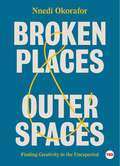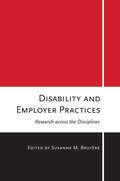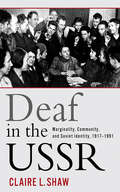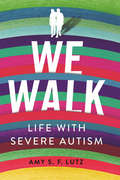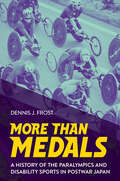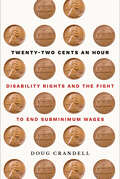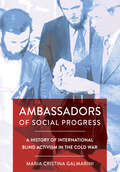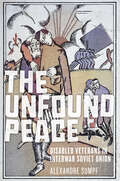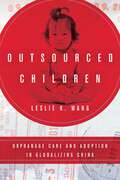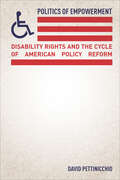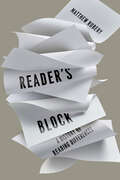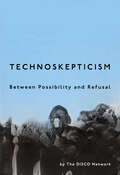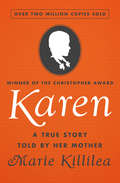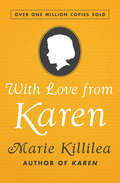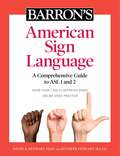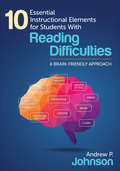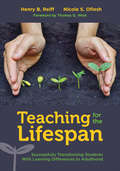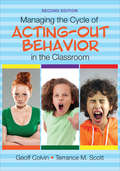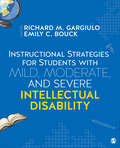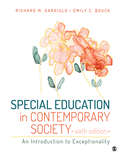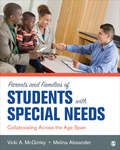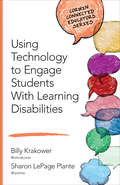- Table View
- List View
Broken Places & Outer Spaces: Finding Creativity in the Unexpected (TED Books)
by Nnedi OkoraforA powerful journey from star athlete to sudden paralysis to creative awakening, award-winning science fiction writer Nnedi Okorafor shows that what we think are our limitations have the potential to become our greatest strengths.Nnedi Okorafor was never supposed to be paralyzed. A college track star and budding entomologist, Nnedi’s lifelong battle with scoliosis was just a bump in her plan—something a simple operation would easily correct. But when Nnedi wakes from the surgery to find she can’t move her legs, her entire sense of self begins to waver. Confined to a hospital bed for months, unusual things begin to happen. Psychedelic bugs crawl her hospital walls; strange dreams visit her nightly. Nnedi begins to put these experiences into writing, conjuring up strange, fantastical stories. What Nnedi discovers during her confinement would prove to be the key to her life as a successful science fiction author: In science fiction, when something breaks, something greater often emerges from the cracks. In Broken Places & Outer Spaces, Nnedi takes the reader on a journey from her hospital bed deep into her memories, from her painful first experiences with racism as a child in Chicago to her powerful visits to her parents’ hometown in Nigeria. From Frida Kahlo to Mary Shelly, she examines great artists and writers who have pushed through their limitations, using hardship to fuel their work. Through these compelling stories and her own, Nnedi reveals a universal truth: What we perceive as limitations have the potential to become our greatest strengths—far greater than when we were unbroken. A guidebook for anyone eager to understand how their limitations might actually be used as a creative springboard, Broken Places & Outer Spaces is an inspiring look at how to open up new windows in your mind.
Disability and Employer Practices: Research across the Disciplines
by Susanne M. BruyèreThis book is about the employment of people with disabilities in the United States and the important role of employer practices. Nearly one in five people report some form of disability, and they are only half as likely to be employed as those without disabilities. With the aging workforce and returning military veterans both contributing to increasing number of disabilities in the workplace, there is an urgent need for better ways to address continuing employment disparities for people with disabilities. Examining employer behaviors is critical to changing this trend. It is essential to understand the factors that motivate employers to engage this workforce and which specific practices are most effective. Disability and Employer Practices features research-based documentation of workplace policies and practices that result in the successful recruitment, retention, advancement, and inclusion of individuals with disabilities. The Cornell team whose work is featured in this book drew from multiple disciplines, data sources, and methodologies to learn where employment disparities for people with disabilities occur and to identify workplace policies and practices that might remediate them. The contributors include individuals with expertise in the fields of business, economics, education, environmental design and analysis, human resources, management, industrial/organizational psychology, public health, rehabilitation psychology, research methods, survey design, educational measurement, statistics, and vocational rehabilitation counseling. Contributors Linda Barrington, Institute for Compensation Studies, ILR School, Cornell University Susanne M. Bruyère, K. Lisa Yang and Hock E. Tan Institute on Employment and Disability, ILR School, Cornell University Hassan Enayati, K. Lisa Yang and Hock E. Tan Institute on Employment and Disability, ILR School, Cornell University William A. Erickson, K. Lisa Yang and Hock E. Tan Institute on Employment and Disability, ILR School, Cornell University Kevin Hallock, Institute for Compensation Studies, ILR School, Cornell University Arun Karpur, K. Lisa Yang and Hock E. Tan Institute on Employment and Disability, ILR School, Cornell University Lisa Nishii, Human Resource Studies, ILR School, Cornell University Ellice Switzer, K. Lisa Yang and Hock E. Tan Institute on Employment and Disability, ILR School, Cornell University Sarah von Schrader, K. Lisa Yang and Hock E. Tan Institute on Employment and Disability, ILR School, Cornell University Sara Van Looy, K. Lisa Yang and Hock E. Tan Institute on Employment and Disability, ILR School, Cornell University
Deaf in the USSR: Marginality, Community, and Soviet Identity, 1917-1991
by Claire L. ShawIn Deaf in the USSR, Claire L. Shaw asks what it meant to be deaf in a culture that was founded on a radically utopian, socialist view of human perfectibility. Shaw reveals how fundamental contradictions inherent in the Soviet revolutionary project were negotiated—both individually and collectively— by a vibrant and independent community of deaf people who engaged in complex ways with Soviet ideology.Deaf in the USSR engages with a wide range of sources from both deaf and hearing perspectives—archival sources, films and literature, personal memoirs, and journalism—to build a multilayered history of deafness. This book will appeal to scholars of Soviet history and disability studies as well as those in the international deaf community who are interested in their collective heritage. Deaf in the USSR will also enjoy a broad readership among those who are interested in deafness and disability as a key to more inclusive understandings of being human and of language, society, politics, and power.
We Walk: Life with Severe Autism (The Culture and Politics of Health Care Work)
by Amy S. LutzIn this collection of beautiful and raw essays, Amy S. F. Lutz writes openly about her experience—the positive and the negative—as a mother of a now twenty-one-year-old son with severe autism. Lutz's human emotion drives through each page and challenges commonly held ideas that define autism either as a disease or as neurodiversity. We Walk is inspired by her own questions: What is the place of intellectually and developmentally disabled people in society? What responsibilities do we, as citizens and human beings, have to one another? Who should decide for those who cannot decide for themselves? What is the meaning of religion to someone with no abstract language? Exploring these questions, We Walk directly—and humanly—examines social issues such as inclusion, religion, therapeutics, and friendship through the lens of severe autism. In a world where public perception of autism is largely shaped by the "quirky geniuses" featured on television shows like The Big Bang Theory and The Good Doctor, We Walk demands that we center our debates about this disorder on those who are most affected by its impacts.
More Than Medals: A History of the Paralympics and Disability Sports in Postwar Japan
by Dennis J. FrostHow does a small provincial city in southern Japan become the site of a world-famous wheelchair marathon that has been attracting the best international athletes since 1981?In More Than Medals, Dennis J. Frost answers this question and addresses the histories of individuals, institutions, and events—the 1964 Paralympics, the FESPIC Games, the Ōita International Wheelchair Marathon, the Nagano Winter Paralympics, and the 2021 Tokyo Summer Games that played important roles in the development of disability sports in Japan. Sporting events in the postwar era, Frost shows, have repeatedly served as forums for addressing the concerns of individuals with disabilities. More Than Medals provides new insights on the cultural and historical nature of disability and demonstrates how sporting events have challenged some stigmas associated with disability, while reinforcing or generating others.Frost analyzes institutional materials and uses close readings of media, biographical sources, and interviews with Japanese athletes to highlight the profound—though often ambiguous—ways in which sports have shaped how postwar Japan has perceived and addressed disability. His novel approach highlights the importance of the Paralympics and the impact that disability sports have had on Japanese society.
Twenty-Two Cents an Hour: Disability Rights and the Fight to End Subminimum Wages
by Doug CrandellIn Twenty-Two Cents an Hour, Doug Crandell uncovers the harsh reality of people with disabilities in the United States who are forced to work in unethical conditions for subminimum wages with little or no opportunity to advocate for themselves, while wealthy CEOs grow even wealthier as a direct result. As recently as 2016, the United States Congress enacted bipartisan legislation which continued to allow workers with disabilities to legally be paid far lower than the federal minimum wage. Drawing on ongoing federal Department of Justice lawsuits, the horrifying story of Henry's Turkey Farm in Iowa, and more, Crandell shows the history of the policies that have led to these unjust outcomes, examines who benefits from this legislation, and asks important questions about the rise of a disability industrial complex. Exposing this complex—which is rooted in profit, lobbying, and playing on the emotions of workers' parents and families, as well as the public—Crandell challenges readers to reexamine how we treat some of our most vulnerable fellow citizens. Twenty-Two Cents an Hour forces the reader to face the reality of this exploitation, and builds the framework needed for reform.
Ambassadors of Social Progress: A History of International Blind Activism in the Cold War (NIU Series in Slavic, East European, and Eurasian Studies)
by Maria Cristina GalmariniAmbassadors of Social Progress examines the ways in which blind activists from the Soviet Union and Eastern Europe entered the postwar international disability movement and shaped its content and its course. Maria Cristina Galmarini shows that the international work of socialist blind activists was defined by the larger politics of the Cold War and, in many respects, represented a field of competition with the West in which the East could shine. Yet, her study also reveals that socialist blind politics went beyond propaganda. When socialist activists joined the international blind movement, they initiated an exchange of experiences that profoundly impacted everyone involved. Not only did the international blind movement turn global disability welfare from philanthropy to self-advocacy, but it also gave East European and Soviet activists a new set of ideas and technologies to improve their own national movements. By analyzing the intersection of disability and politics, Ambassadors of Social Progress enables a deeper, bottom-up understanding of cultural relations during the Cold War. Galmarini significantly contributes to the little-studied history of disability in socialist Europe, and ultimately shows that disability activism did not start as an import from the West in the post-1989 period, but rather had a long and meaningful tradition that was rooted in the socialist system of welfare and needed to be reinvented when this system fell apart.
The Unfound Peace: Disabled Veterans in Interwar Soviet Union (NIU Series in Slavic, East European, and Eurasian Studies)
by Alexandre SumpfThe Unfound Peace is the first book dealing with disabled former servicemen of tsarist Russia in all regards—socioeconomic status, healthcare, social reintegration into families and communities, self-representation—and the only one comparing World War I and Russian Civil War veterans. Alexandre Sumpf considers the ways disabled Great War veterans tried to live under the Bolsheviks and compares their experiences with those of the Red Army veterans who received special considerations from the new regime. Offering a history of the body and health in relation to work, The Unfound Peace also compares the situation of disabled veterans with that of disabled workers who were subject to the same demands of extreme productivity but benefited from better social protection, though they dealt with accusations that they were faking their disabilities. Sumpf's exploration of disabled veterans, with transnational comparisons, offers the possibility of rereading the history of the first generation of Soviets through the collective and private memory of war, in the USSR and in exile.
Outsourced Children: Orphanage Care and Adoption in Globalizing China
by Leslie K. WangIt's no secret that tens of thousands of Chinese children have been adopted by American parents and that Western aid organizations have invested in helping orphans in China--but why have Chinese authorities allowed this exchange, and what does it reveal about processes of globalization? Countries that allow their vulnerable children to be cared for by outsiders are typically viewed as weaker global players. However, Leslie K. Wang argues that China has turned this notion on its head by outsourcing the care of its unwanted children to attract foreign resources and secure closer ties with Western nations. She demonstrates the two main ways that this "outsourced intimacy" operates as an ongoing transnational exchange: first, through the exportation of mostly healthy girls into Western homes via adoption, and second, through the subsequent importation of first-world actors, resources, and practices into orphanages to care for the mostly special needs youth left behind. Outsourced Children reveals the different care standards offered in Chinese state-run orphanages that were aided by Western humanitarian organizations. Wang explains how such transnational partnerships place marginalized children squarely at the intersection of public and private spheres, state and civil society, and local and global agendas. While Western societies view childhood as an innocent time, unaffected by politics, this book explores how children both symbolize and influence national futures.
Politics of Empowerment: Disability Rights and the Cycle of American Policy Reform
by David PettinicchioDespite the progress of decades-old disability rights policy, including the landmark Americans with Disabilities Act, threats continue to undermine the wellbeing of this population. The U.S. is, thus, a policy innovator and laggard in this regard. In Politics of Empowerment, David Pettinicchio offers a historically grounded analysis of the singular case of U.S. disability policy, countering long-held views of progress that privilege public demand as its primary driver. By the 1970s, a group of legislators and bureaucrats came to act as "political entrepreneurs." Motivated by personal and professional commitments, they were seen as experts leading a movement within the government. But as they increasingly faced obstacles to their legislative intentions, nascent disability advocacy and protest groups took the cause to the American people forming the basis of the contemporary disability rights movement. Drawing on extensive archival material, Pettinicchio redefines the relationship between grassroots advocacy and institutional politics, revealing a cycle of progress and backlash embedded in the American political system.
Reader's Block: A History of Reading Differences
by Matthew RuberyWhat does the term "reading" mean? Matthew Rubery's exploration of the influence neurodivergence has on the ways individuals read asks us to consider that there may be no one definition. This alternative history of reading tells the stories of "atypical" readers and the impact had on their lives by neurological conditions affecting their ability to make sense of the printed word: from dyslexia, hyperlexia, and alexia to synesthesia, hallucinations, and dementia. Rubery's focus on neurodiversity aims to transform our understanding of the very concept of reading. Drawing on personal testimonies gathered from literature, film, life writing, social media, medical case studies, and other sources to express how cognitive differences have shaped people's experiences both on and off the page, Rubery contends that there is no single activity known as reading. Instead, there are multiple ways of reading (and, for that matter, not reading) despite the ease with which we use the term. Pushing us to rethink what it means to read, Reader's Block moves toward an understanding of reading as a spectrum that is capacious enough to accommodate the full range of activities documented in this fascinating and highly original book. Read it from cover to cover, out of sequence, or piecemeal. Read it upside down, sideways, or in a mirror. For just as there is no right way to read, there is no right way to read this book. What matters is that you are doing something with it—something that Rubery proposes should be called "reading."
Technoskepticism: Between Possibility and Refusal (Sensing Media: Aesthetics, Philosophy, and Cultures of Media)
by DISCO NetworkFrom Munchausen by Tiktok to wellness apps to online communities to AI, the DISCO Network explores the possibilities that technoskepticism can create. This is a book about possibility and refusal in relation to new technologies. Though refusal is an especially powerful mode—particularly for those who have historically not been given the option to say no—people of color and disabled people have long navigated the space between saying yes and saying no to the newest technologies. Technoskepticism relates some of these stories to reveal the possibilities skepticism can create. The case for technoskepticism unfolds across three sections: the first focused on disability, the creative use of wellness apps, and the desire for diagnosis; the second on digital nostalgia and home for Black and Asian users who produced communities online before home pages gave way to profiles; and the third focused on the violence inherent in A.I.-generated Black bodies and the possibilities for Black style in the age of A.I. Acknowledging how the urge to refuse new technologies emerges from specific racialized histories, the authors also emphasize how care can look like an exuberant embrace of the new.
Karen: A True Story Told by Her Mother
by Marie KillileaWinner of the Christopher Award: This bestseller tells the inspirational true story of a girl with cerebral palsy and the mother who wouldn&’t give up on her. In 1940, when Karen Killilea was born three months premature and developed cerebral palsy, doctors encouraged her parents to put her in an institution and forget about her. At the time, her condition was considered untreatable, and institutionalization was the only recourse. But in a revolutionary act of faith and love, the Killileas never gave up hope that Karen could lead a successful life. Written by Karen&’s mother, Marie, this memoir is a profound and heartwarming personal account of a young mother&’s efforts to refute the medical establishment&’s dispiriting advice, and her daughter&’s extraordinary triumph over seemingly insurmountable odds. Marie&’s activism spread awareness of the mistreatment of disabled people in America and led to the formation of multiple foundations, including United Cerebral Palsy. A larger-than-life story, Karen tells of a family&’s courage, patience, and struggle in the face of extreme difficulty. The New York Times wrote, &“You&’ll want to read it most for Karen&’s own words: &‘I can walk, I can talk. I can read. I can write. I can do anything.&’&”
With Love from Karen
by Marie KillileaThe Killilea family returns in the heartwarming sequel to national bestseller Karen.With Love from Karen picks up five years after the conclusion of Karen, the miraculous and true story of a girl with cerebral palsy who triumphed against all odds. It follows the Killileas through Karen&’s teen years and into adulthood. Karen and her family continue to face seemingly insurmountable obstacles: They must fight for Karen&’s right to attend public school, support Karen in her dream to raise and exhibit champion show dogs, and encourage her in her decision to use a wheelchair or walk on her own. Once again, the Killilea family proves that the power of faith, love, and courage in the face of adversity can make miracles happen.
Barron's American Sign Language: A Comprehensive Guide to ASL 1 and 2 with Online Video Practice
by David A. Stewart Jennifer StewartBarron&’s American Sign Language is a brand-new title on ASL that can be used in the classroom, as a supplemental text to high school and college courses, or for anyone who wants to learn proper ASL.The only book with comprehensive instruction and online graded video practice quizzes, plus a comprehensive final video exam.Content includes topics on the Deaf culture and community, ASL Grammar, fingerspelling, combining signs to construct detailed sentences, Everyday ASL, and much more.More than 1,000 illustrations of signs with instructions on movement--step-by-step with dialogue, tip boxes, and practice exercises and quizzes throughout to reinforce retention and to track your progress.
10 Essential Instructional Elements for Students With Reading Difficulties: A Brain-Friendly Approach
by Andrew P. JohnsonBrain-friendly strategies to help all students become lifelong readers Learning to read is more than just an educational issue; it’s a social justice issue. Did you know that struggling readers are twice as likely as their peers to drop out of high school? Through time-tested, research-based neurocognitive teaching strategies, 10 Essential Instructional Elements for Students with Reading Difficulties will enable you to hone readers’ skills and help students from all grade levels develop their ability to create meaning from print. Drawing from five key areas of neurocognitive research, Andrew Johnson provides a ten-point teaching strategy that encompasses vocabulary, fluency, comprehension, writing and more. A key resource for creating intervention plans for struggling readers, features include: Information on the often-overlooked importance of emotions in the process of overcoming reading struggles Strategies to promote voluntary reading, even for the most reluctant students Useful resources such as graphic organizers, additional reading and writing activities, and QR codes that link to videos Use these strategies today and you can count on more students leaving your classrooms as fluent, lifelong readers. "Dr. Johnson tells the story of reading in a logical and clear manner with a book that is excellently researched, immaculately referenced, and full of practical tips for the practitioner." Terry Bernstein, Former Senior Literacy Difficulties Specialist London Boroughs of Camden and Westminster, UK "This is the text I wish I had when I began to teach. Dr. Johnson clearly illustrates the process our brain uses to create meaning from text." Marty Duncan, Ed.D., Author and Former Educator
Teaching for the Lifespan: Successfully Transitioning Students With Learning Differences to Adulthood
by Henry B. Reiff Nicole S. OfieshYour step-by-step guide to successful transition planning Finally, here’s a practical guide that makes transition planning easier. Backed by the latest research in learning and development, Teaching for the Lifespan provides you with the pedagogical best practices to promote your students’ strengths for life-long success. You’ll benefit from: A deep understanding of the educational, vocational, social, and emotional dimensions of adulthood for students with learning differences Techniques to help students with learning differences develop an awareness of proactive behaviors Strategies to help all learners achieve the demands of the Common Core and high-stakes assessments through Universal Design for Learning (UDL)
Managing the Cycle of Acting-Out Behavior in the Classroom
by Terrance M. Scott Geoffrey T. ColvinMinimize problem behavior and maximize student success! Acting-out behavior by students manifests in ways that make classroom management and teaching very challenging. Building on a model using seven phases of acting-out behavior presented in the first edition, the newly updated edition draws on new research in applied behavior analysis, sound instructional principles, and functional behavior assessment to deliver a clear roadmap for educators to design interventions in a clear, systematic, and achievable matter. Features include: Managing each phase of the acting-out cycle—from structuring the classroom, to handling escalated behavior, to recovery Case studies that distill concrete action steps from the book’s concepts Checklists, tools, resources, and templates for applying the book’s principles to any classroom
Instructional Strategies for Students With Mild, Moderate, and Severe Intellectual Disability
by Richard M. Gargiulo Emily C. BouckStrategies for Students with Mild, Moderate, and Severe Intellectual Disabilities is a textbook for undergraduate and graduate students enrolled in special and general education teacher preparation programs (as well as practicing professionals) offering a solid, research based text on instructional methodologies for teaching students with intellectual disability across the spectrum of intellectual abilities. The book addresses both academic and functional curricula in addition to behavioral interventions. Additionally, Instructional Strategies for Students Mild, Moderate, and Severe Intellectual Disability adopts developmental or life span approach covering preschool through adolescence and young adulthood.
Instructional Strategies for Students With Mild, Moderate, and Severe Intellectual Disability
by Richard M. Gargiulo Emily C. BouckStrategies for Students with Mild, Moderate, and Severe Intellectual Disabilities is a textbook for undergraduate and graduate students enrolled in special and general education teacher preparation programs (as well as practicing professionals) offering a solid, research based text on instructional methodologies for teaching students with intellectual disability across the spectrum of intellectual abilities. The book addresses both academic and functional curricula in addition to behavioral interventions. Additionally, Instructional Strategies for Students Mild, Moderate, and Severe Intellectual Disability adopts developmental or life span approach covering preschool through adolescence and young adulthood.
Special Education in Contemporary Society: An Introduction to Exceptionality
by Richard M. Gargiulo Emily C. Bouck2015 Recipient of the Textbook Excellence Award from the Text and Academic Authors Association (TAA) The Sixth Edition of Richard Gargiulo’s well-respected Special Education in Contemporary Society: An Introduction to Exceptionality offers a comprehensive, engaging, and easy-to-read introduction to special education. Grounded in research and updated to reflect the most current thinking and standards of the field, the book provides students with the skills and knowledge to become successful teachers. Richard Gargiulo and new co-author Emily Bouck encourage a deep awareness and understanding of the human side of special education. Their book provides students a rare look into the lives of exceptional students and their families, as well as the teachers that work with exceptional persons throughout their lives. The new edition maintains the broad context and research focus for which the book is known, while expanding on current trends and contemporary issues to better serve both pre-service and in-service teachers of exceptional individuals. The text is organized into two distinct parts to offer students a truly comprehensive and humane understanding of exceptionality. In Part I, readers are provided strong foundational perspective on broad topics that affect all individuals with an exceptionality. In Part II, the authors engage students with thorough examinations of individual exceptionalities, and discuss historical, personal, and educational details of each exceptionality as it affects a person across the lifespan.
Special Education in Contemporary Society: An Introduction to Exceptionality
by Richard M. Gargiulo Emily C. Bouck2015 Recipient of the Textbook Excellence Award from the Text and Academic Authors Association (TAA) The Sixth Edition of Richard Gargiulo’s well-respected Special Education in Contemporary Society: An Introduction to Exceptionality offers a comprehensive, engaging, and easy-to-read introduction to special education. Grounded in research and updated to reflect the most current thinking and standards of the field, the book provides students with the skills and knowledge to become successful teachers. Richard Gargiulo and new co-author Emily Bouck encourage a deep awareness and understanding of the human side of special education. Their book provides students a rare look into the lives of exceptional students and their families, as well as the teachers that work with exceptional persons throughout their lives. The new edition maintains the broad context and research focus for which the book is known, while expanding on current trends and contemporary issues to better serve both pre-service and in-service teachers of exceptional individuals. The text is organized into two distinct parts to offer students a truly comprehensive and humane understanding of exceptionality. In Part I, readers are provided strong foundational perspective on broad topics that affect all individuals with an exceptionality. In Part II, the authors engage students with thorough examinations of individual exceptionalities, and discuss historical, personal, and educational details of each exceptionality as it affects a person across the lifespan.
Parents and Families of Students With Special Needs: Collaborating Across the Age Span
by Dr Vicki A. McGinley Dr Melina AlexanderParents and Families of Students With Special Needs: Collaborating Across the Age Span teaches students the skills they need to effectively collaborate with parents and families to ensure a child's success in the classroom. Authors Vicki A. McGinley and Melina Alexander’s text takes a lifespan approach with a special emphasis on the critical transition points in a child’s life. Information is provided on what can be seen at each stage of an individual with disabilities’ development, and addresses concerns and needs that families may have during these unique phases of growth. Chapters written by professors and professionals who are also parents of students with special needs bring a diverse range of voices into the narrative. The authors provide an in-depth discussion of how parents and families are affected by particular disabilities, family system theory, the laws that affect individuals with disabilities, and assessments for individuals with disabilities.
Parents and Families of Students With Special Needs: Collaborating Across the Age Span
by Dr Vicki A. McGinley Dr Melina AlexanderParents and Families of Students With Special Needs: Collaborating Across the Age Span teaches students the skills they need to effectively collaborate with parents and families to ensure a child's success in the classroom. Authors Vicki A. McGinley and Melina Alexander’s text takes a lifespan approach with a special emphasis on the critical transition points in a child’s life. Information is provided on what can be seen at each stage of an individual with disabilities’ development, and addresses concerns and needs that families may have during these unique phases of growth. Chapters written by professors and professionals who are also parents of students with special needs bring a diverse range of voices into the narrative. The authors provide an in-depth discussion of how parents and families are affected by particular disabilities, family system theory, the laws that affect individuals with disabilities, and assessments for individuals with disabilities.
Using Technology to Engage Students With Learning Disabilities (Corwin Connected Educators Series)
by William A. Krakower Sharon LePage PlanteLeverage technology to engage students with learning disabilities! Harness the power of today’s technology to improve learning and engagement for students with learning disabilities. By engaging students with learning disabilities using the technology already at your fingertips, you’ll see your students begin to thrive and grow in exciting new ways. In this volume in the Connected Educators Series, you’ll discover: New ideas for using assistive technology to teach core subjects and study skills How to build positive opportunities for students to show what they know Tools to provide better content accessibility How to help students connect and share through technology tools The Corwin Connected Educators series is your key to unlocking the greatest resource available to all educators: other educators. Being a Connected Educator is more than a set of actions: it’s a belief in the potential of technology to fuel lifelong learning. "Every educator can implement these methodologies to transform their learning environment into a place that honors and respects the differences of EVERY learner. Follow these simple steps: Read the book. Employ the content. Observe the successes. Then share those achievements with others!" Christopher R. Bugaj, Author and Presenter The Practical (and Fun) Guide to Assistive Technology in Public Schools "The authors have produced a practical approach to engaging students with learning disabilities. Educators will find great tools, ideas, and strategies to support students with learning challenges. Sprinkled throughout the book are case studies from noted educators, which are useful when thinking through the process of integrating technology in the classroom. This is a must read!" Brian S. Friedlander, Ph.D. AssistiveTek, LLC
